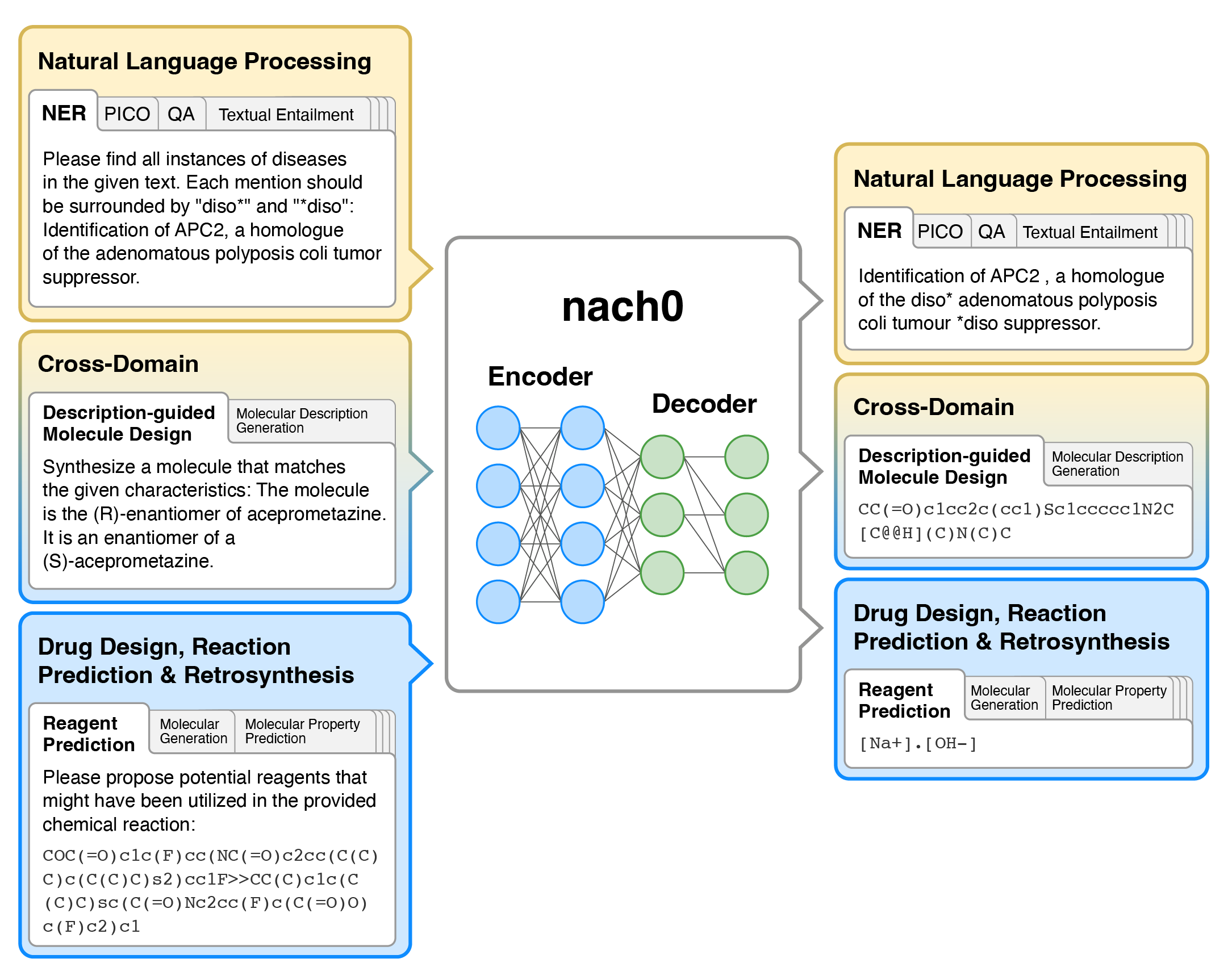nach0
Multimodal Natural and Chemical Languages Foundation Model
📃 Paper • ⏬ Base nach0 • ⏬ Large nach0

Overview
nach0 is a multi-domain and multi-task encoder-decoder LLM pre-trained on unlabeled text from scientific literature, patents, and molecule strings to incorporate a range of chemical and linguistic knowledge.
We employed instruction tuning, where specific task-related instructions are utilized to fine-tune nach0 for the final set of tasks. To train nach0 effectively, we leverage the NeMo framework, enabling efficient parallel optimization of both base and large model versions.
Extensive experiments demonstrate that our model outperforms state-of-the-art baselines on single-domain and cross-domain tasks. Furthermore, it can generate high-quality outputs in molecular and textual formats, showcasing its effectiveness in multi-domain setups.
Tasks
Datasets used for training and evaluation. Colour represents the type of tasks. Yellow and blue datasets are single-domain, typically requiring regression/classification losses or generation in the target domain (natural language or SMILES strings). Gradients from yellow to blue represent cross-domain generation tasks that require natural language input and SMILES output, or vise versa.
Model Usage Guide
To use model for the inference follow the steps bellow:
- Preprocess the input by replacing the atom tokens with special tokens.
from transformers import AutoModelForSeq2SeqLM, AutoTokenizer
import re
from rdkit.Chem import MolFromSmiles
import string
from rdkit import RDLogger
RDLogger.DisableLog('rdApp.*')
atoms_tokens = ['Ag','Al','As','Au','B','Ba','Bi','Br','C','Ca',
'Cd','Cl','Co','Cr','Cs','Cu','F','Fe','Ga','Gd',
'Ge','H','Hg','I','In','K','Li','M','Mg','Mn',
'Mo','N','Na','O','P','Pt','Ru','S','Sb','Sc',
'Se','Si','Sn','V','W','Z','Zn','c','e','n','o','p','s']
atoms_tokens = sorted(atoms_tokens, key=lambda s: len(s), reverse=True)
SMI_REGEX_PATTERN = r"(\[|\]|\(|\)|\.|=|#|-|\+|\\|\/|:|~|@|\?|>>?|\*|\$|\%[0-9]{2}|[0-9]|" + \
'|'.join(atoms_tokens) + ")"
regex = re.compile(SMI_REGEX_PATTERN)
def clean_output_sequence(output_sequence):
return output_sequence.replace('</s>', '').replace('<sm_', '').replace(' sm_', '').replace('>', '').strip()
def add_special_symbols(text):
output = []
for word in text.split():
tokens = [token for token in regex.findall(word)]
if len(tokens) > 4 and (word == ''.join(tokens)) and MolFromSmiles(word):
output.append(''.join(['<sm_'+t+'>' for t in tokens]))
else:
output.append(word)
return ' '.join(output)
PROMPT = """Given the following reactants and reagents, please provide a possible product.
CCN(CC)CC.CCN=C=NCCCN(C)C.CN(C)C=O.Cl.NC1=CC=C(Cl)C=C1N.O.O=C(O)CCCCCNC(=O)C=C1C2=CC=CC=C2C2=CC=CC=C12.OC1=CC=CC2=C1N=NN2.[Cl-].[Na+]"""
PROMPT = add_special_symbols(PROMPT)
- Load the model checkoint
model = AutoModelForSeq2SeqLM.from_pretrained('insilicomedicine/nach0_base')
tokenizer = AutoTokenizer.from_pretrained('insilicomedicine/nach0_base')
- Generate response to prompt and replace special tokens with corresponding atom tokens
input_text_ids = tokenizer(PROMPT, padding="longest", max_length=512, truncation=True, return_tensors="pt")
generated_text_ids = model.generate(**input_text_ids, do_sample=True, top_k=100, top_p=0.95, max_length=512)
generated_text = tokenizer.batch_decode(generated_text_ids, skip_special_tokens=True)[0]
generated_text = clean_output_sequence(generated_text)
# NC1=CC=C(Cl)C=C1NC(=O)CCCCCNC(=O)C=C1C2=CC=CC=C2C2=CC=CC=C12
Usage for Large Model Version
To use the large model version for inference, please refer to the NeMo project.
The simplest way to use the large version of the model is to run the megatron_t5_seq2seq_eval.py or megatron_t5_seq2seq_finetune.py script.
Prior to executing the script, prepare the input (prompts) and output (responses) files and set up the config file. The input file should have prompts on each line, which need to be preprocessed using the add_special_symbols function mentioned above.
In the configuration file, the following keys should be set:
Set Input and Target Files: Set the
src_file_nameandtgt_file_namefields to the files where the input (prompts) and target (responses) data are stored.Specify the Checkpoint Path: Set the
restore_from_pathfield to the NeMo checkpoint path.Enable Predictions Writing: Set
write_predictions_to_fileto True.Define Output File Prefix: Alter the
output_file_path_prefixfield to set the output file prefix.
After completing these steps, run the script to perform inference.
Usage and License
Please note that all model weights are exclusively licensed for research purposes. The accompanying dataset is licensed under CC BY 4.0, which permits solely non-commercial usage. We emphatically urge all users to adhere to the highest ethical standards when using our models, including maintaining fairness, transparency, and responsibility in their research. Any usage that may lead to harm or pose a detriment to society is strictly forbidden.
References
If you use our repository, please cite the following related paper:@article{D4SC00966E,
author ="Livne, Micha and Miftahutdinov, Zulfat and Tutubalina, Elena and Kuznetsov, Maksim and Polykovskiy, Daniil and Brundyn, Annika and Jhunjhunwala, Aastha and Costa, Anthony and Aliper, Alex and Aspuru-Guzik, Alán and Zhavoronkov, Alex",
title ="nach0: multimodal natural and chemical languages foundation model",
journal ="Chem. Sci.",
year ="2024",
volume ="15",
issue ="22",
pages ="8380-8389",
publisher ="The Royal Society of Chemistry",
doi ="10.1039/D4SC00966E",
url ="http://dx.doi.org/10.1039/D4SC00966E",
}
- Downloads last month
- 24